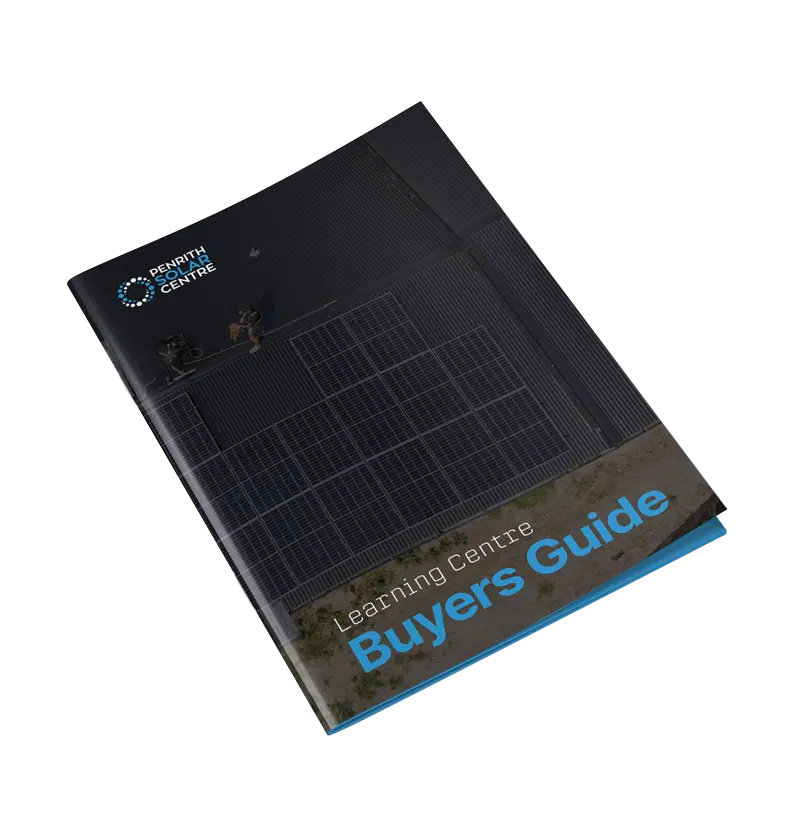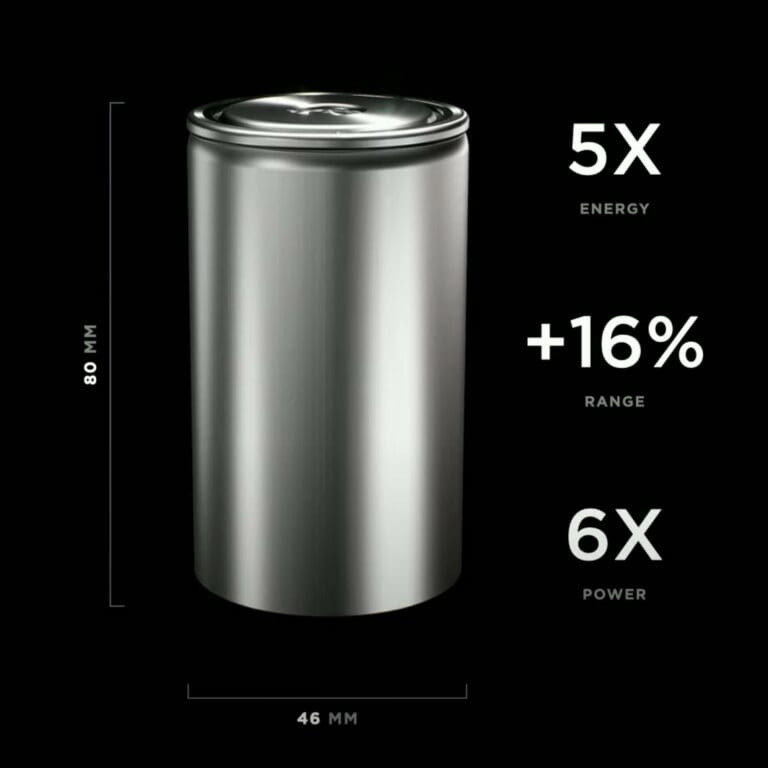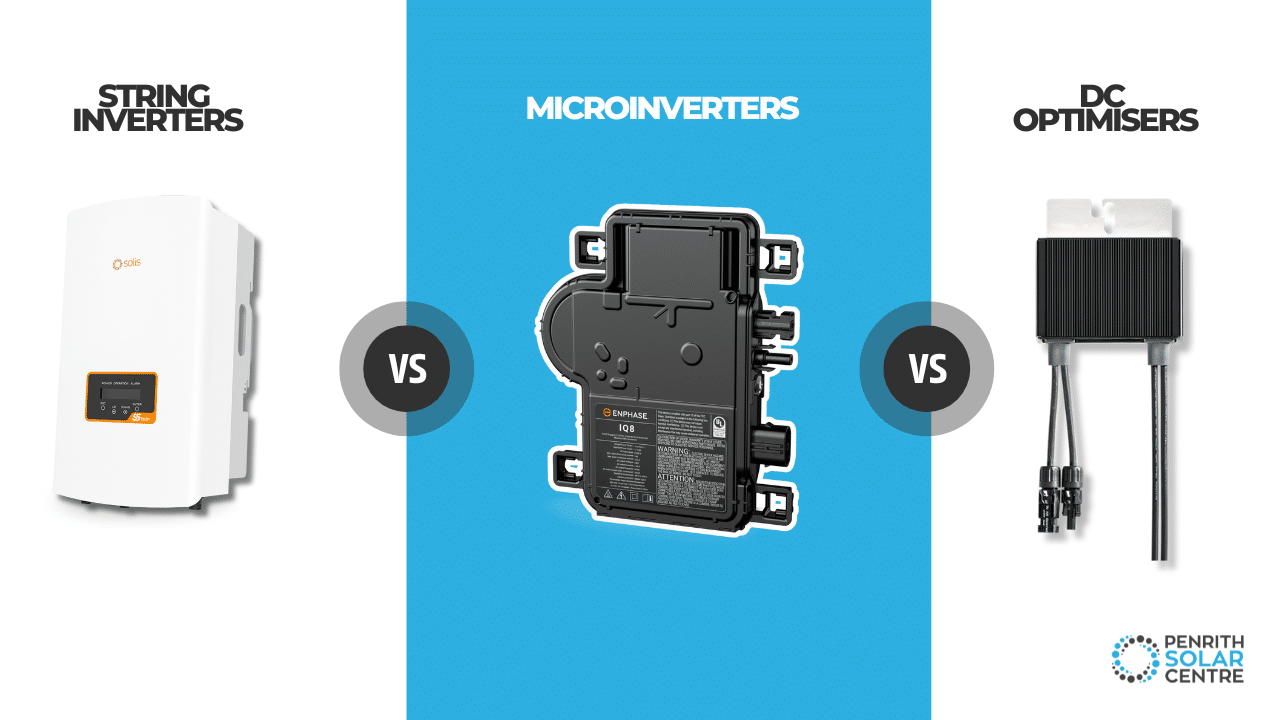
Are you researching different solar technologies for your home? What a power move. Okay, sorry about the pun (not really though).
As you’ve studied up on different solar systems, you’ve probably come across the types of systems that you can install. Do you go with a string inverter system or a microinverter system for your solar panels? There’s a lot to consider: cost, efficiency, and return on investment – just to name a few things. Whichever type of solar system you choose should be based on your unique energy needs.
DC optimisers were developed by string system manufacturers to address some of the problems inherent in string inverter systems. Since then, the solar community has been debating which solar system is better for solar panel efficiency: microinverters, string inverters, or string inverters with DC optimisers.
Microinverters and DC optimisers are completely different technologies but are often grouped together because they both enable panel-level optimisation. They’re both mounted underneath individual solar panels and they both play a part in getting power to your home, battery, or the grid. There are some key differences between these technologies.
At Penrith Solar Centre, we only install microinverter systems. However, we want you to be a happy and informed shopper, empowered to make the right choice for your unique needs. In this article, you’ll receive an unbiased and honest look at all three of these technologies so you can decide for yourself what is going to be a better fit for your home. After all, you live in it, not us.
In this article, you’ll learn:
- What is a String Inverter?
- What is a DC Optimiser?
- What is a Microinverter?
- Comparison Chart and Context
Here are the categories we’re going to compare:
- Cost
- Efficiency
- Functionality
- Reliability and Durability
- Safety
- Compatibility and Scalability
- Monitoring and Management
You’re going to be an expert by the end of this article.
What is a String Inverter?
A string inverter is a boxy device that is usually fixed on the side of a house with solar panels on the roof. Its purpose is to convert the DC power that’s absorbed by the panels into AC power to feed the appliances in the house. It’s called a “string” inverter because it’s connecting a string of solar panels wired together in a solar array.
String inverter solar systems present a short-term cost advantage because they require less equipment than microinverter solar systems. Installing a string inverter system is a wonderful way to save on the upfront costs of a solar system if the system is small.
They have the capacity to manage the power output of a string of 5 – 13 (approximately) panels. In a string inverter setup, the performance of the entire solar system is limited by the lowest-performing panel.
If one panel is obstructed by debris or is shaded, it will affect the power output of all the other panels on the string connected to the same string inverter. They work like Christmas lights (roughly): if one light goes out, the entire string goes dark. This overall efficiency reduction is the main disadvantage of string inverter systems.
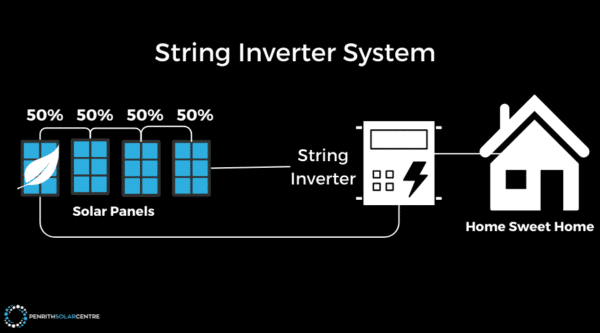
If you’re interested in learning why other solar companies recommend a string inverter system, you might want to check out the following article titled, Why Do Companies Sell 6.6kW String Systems with 5kW Inverters?
What is a DC Optimiser?
Because one of the drawbacks of string inverter systems is that if one panel is shaded or underperforming, the whole system slows down and the output power is reduced considerably.
Enter the DC optimiser. Think of them as coaches who train each panel to be its best. They allow string inverter systems to bypass shaded or underperforming panels. Regular string inverters working without optimisers can’t achieve this.

The DC optimiser is attached to individual solar panels to make certain that each one outputs the maximum amount of DC power they are capable of outputting individually. While the technology for different brands will vary slightly, the general principle is that the inverter for the string system tells the optimisers how to behave for the best output.
When one panel is dropping in voltage because it’s experiencing some shade, debris, or a bad orientation, then the current for the entire string drops. The drop is registered by the inverter, and it induces the circuits to boost the other optimisers on the other panels to compensate for the loss and prevent the entire string from underperforming.
Then, the optimised electricity is sent to the central inverter, usually on the side of the house somewhere, for conversion from DC electricity to AC electricity.

DC optimisers can be added to existing solar installations, making them great for retrofit projects. They can enhance the performance of older systems that have shading issues or mismatching panels.
However, a DC optimiser is not interchangeable with a microinverter. While they are similar in monitoring and maximising panel output, the microinverter converts DC power into AC power at the panel. A DC optimiser, well… optimises the DC power and sends it to the central inverter on the side of the house.
A string inverter system with DC optimisers is still more susceptible to malfunction than a microinverter system because there’s still a central point of failure in the system: the string inverter itself.
If you’re interested in learning a bit more about shopping for a solar system, you might want to check out the following article titled, 6 Mistakes to Avoid When Buying Solar.
Ready to go solar? Click here.
What is a Microinverter?
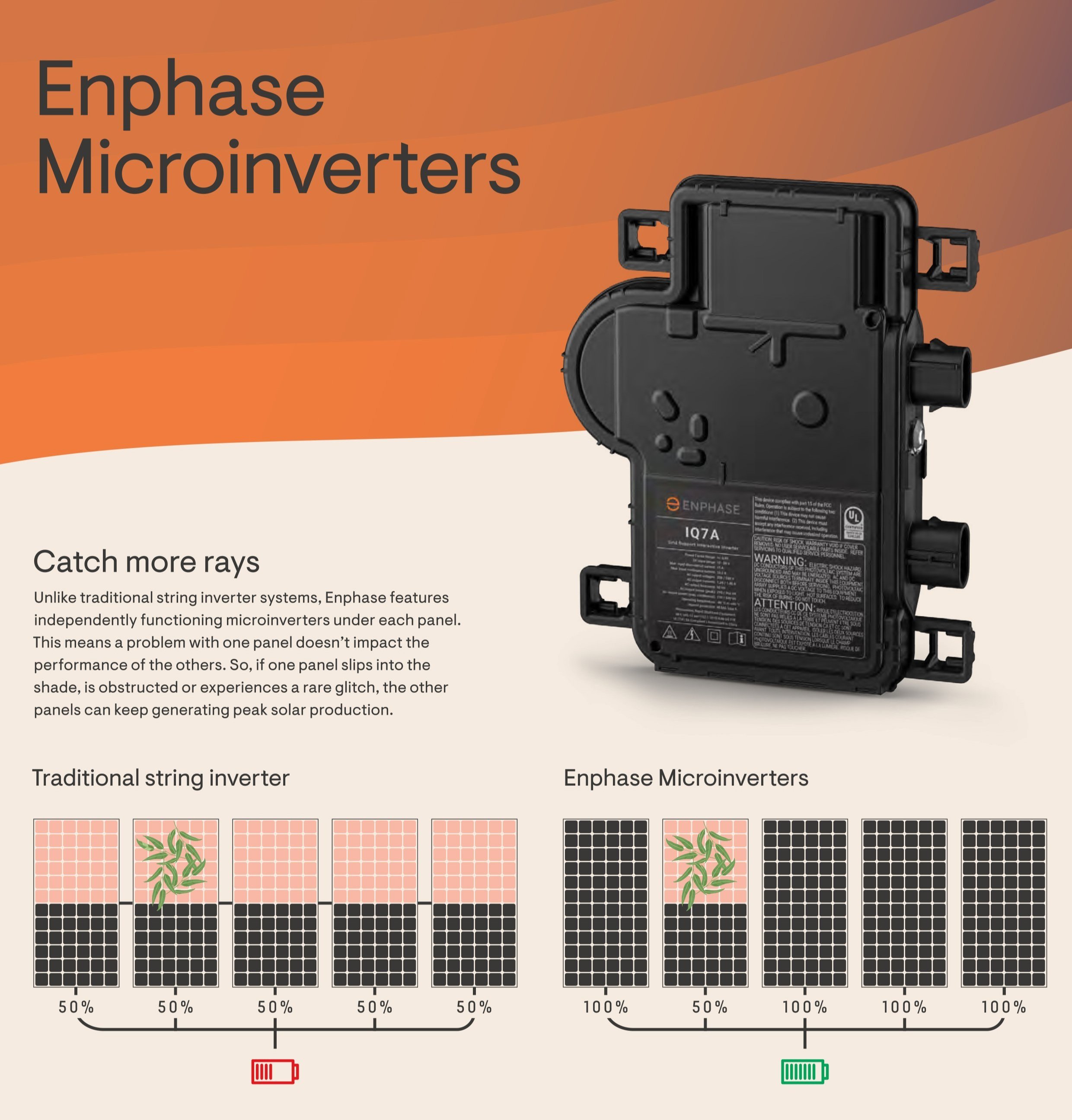
Microinverters are miniaturised inverters – micro, if you will – that are mounted under each solar panel in a microinverter solar system. They transform the power that each panel collects (DC power) into the kind of electricity your home uses (AC power). If one panel is shaded or is malfunctioning, the other panels will still perform independently. Distributing the power conversion this way is called decentralisation.
A decentralised system improves energy efficiency. Replacing a single microinverter out of 20 will reduce your system’s output by 5%, leaving 95% of the system still sending electricity to the house. Your overall power only drops a little because only one panel is affected.
Microinverters are great for roofs with shaded parts during the day. They work independently, so if one panel is in trouble, it doesn’t bring down the whole team. They fit well where trees, buildings, or other things cast shadows.
For a deeper dive into microinverters, read this article about The Benefits of Microinverters.
Comparison Chart and Context
Hold on to your solar panels as we journey into the differences between string inverters, microinverters, and string inverters with DC optimisers.
This table is designed to give you a quick glimpse into the strengths and weaknesses of each piece of technology and which is a better solution for the specific criteria.
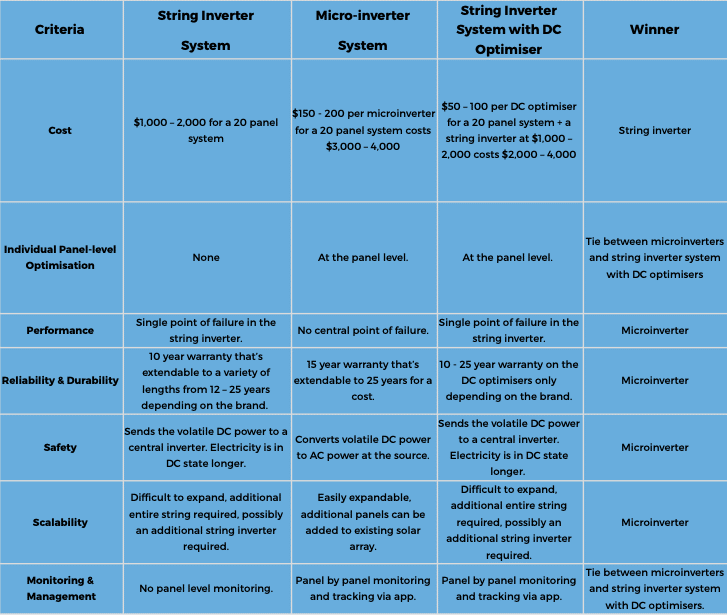
So grab your shades and check out this illuminating comparison!
Cost: Microinverters are a larger upfront expense. That being said, you must consider the return on investment of your solar system. The individual panel-level optimisation can lead to savings down the road.
A string inverter system with DC optimisers balances cost and performance, particularly for larger installations. Keep in mind that replacing the equipment every ten years or purchasing an extended warranty should be factored into the cost.
This is especially true if you’re serious about a string inverter system or a string inverter system with DC optimisers.
Individual Panel-Level Optimisation: Both microinverters and string inverter systems with DC optimisers operate at the individual panel level. This optimises energy output.
Their mechanism purpose is different, but both technologies make sure that each solar panel operates at its peak. Even when panels are shaded or mismatched. Sadly, a string inverter system working on its own has no panel-level optimisation.
Performance: Even though all three systems are neck and neck in performance on a normal sunny day without debris, shade, or roof orientation factored in, there is still one thing to consider: the central point of failure. Microinverters have no central point of failure (I’ll resist the temptation to post an image of the Death Star exhaust port).
String inverter systems and string inverter systems with DC optimisers still rely on a central string inverter (on the side of the house) for overall system performance. This is important because if that string inverter fails, it shuts down the whole system. We used it as our way to measure the performance in the above table for this reason.
Reliability & Durability: If reliability is an issue, you must again look at the decentralised system and the advantages of it, which we discussed in the above bullet point.
While string inverter systems, microinverter systems, and string inverter systems with DC optimisers typically come with warranties that can be extended to 25 years, the central string inverter that string inverter systems with or without a DC optimiser rely on don’t last that long.
Repairing and replacing it can be a genuine hassle, especially in the rapidly evolving solar industry. Mixing and matching equipment from different brands can be an issue too, but we’ll get into that shortly.
Safety: Microinverter systems are safer. Full stop. They convert DC to AC power at the panel and then export it to the home.
String inverters systems and string inverter systems with DC optimisers harvest the DC electricity and then send it to the string inverter on the side of the house where the DC power is converted to AC power.
This creates a safety concern, as DC power is more volatile than AC power. The longer it’s in that form, the greater the risk of fire if that journey from the roof to the house is interrupted.
Scalability: String inverter systems with or without DC optimisers are limited in their expansion capability. When you add panels to a string inverter system, you must add a second string system to your roof and there’s a high probability that you’ll need to install a second string inverter as well. You cannot simply plug a new row of panels into the old one and feed both to the same string inverter on the side of the home.
With a microinverter system, you can do that. You simply add panels to an existing solar array. They are considerably easier to expand (and probably less expensive too, depending on what you’re doing) if your energy needs change.
There’s something else to consider as well: in the case of some optimised inverter solar system companies like SolarEdge, the string inverter is only compatible with that company’s optimisers and other equipment like batteries. This makes is difficult to mix and match equipment should something fail or if you want to expand your system.
Monitoring & Management: Both microinverter systems and string inverter systems with DC optimisers use real-time monitoring and tracking. They can continuously monitor the performance of each panel and allow you to adjust productivity based on conditions.
All of this is done through an app on your phone or computer. Panel-level monitoring allows you and solar professionals to identify issues quickly and maximise the system’s efficiency over time. String inverter systems working without DC optimisers can’t do anything at the panel level, their monitoring is just one readout for the whole system.
If you’re interested in learning a bit more about the process of choosing components for your solar system, you might want to check out the following article titled, How to Shop for a Solar System.
Click here to start saving with solar.
String Inverter vs Microinverter vs DC Optimisers: Which is Right for You?
To recap: string inverter systems, microinverter systems, and string inverter systems with DC optimisers are advanced solutions to enhance solar system performance. The choice between the which one you’ll choose depends on cost, type of solar system, and safety, to name a few considerations. Microinverters give you individual panel independence, while DC optimisers work with string systems to maximise their performance.
So which one will you choose? It depends on your needs and what you want. There’s no simple solution to the pros and cons of these pieces of equipment. Every homeowner has different goals and different budgets.
All that being said, you should have a better understanding of each option. You’re well on your way to making an informed choice that will fit your solar power needs.
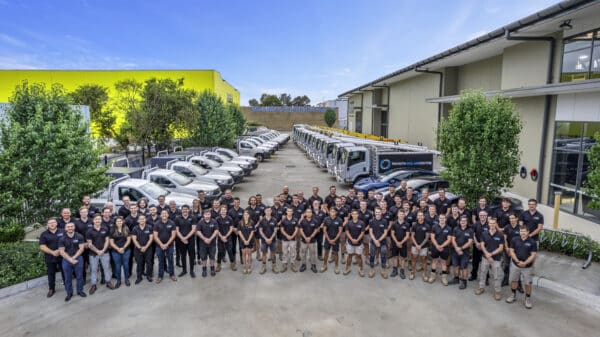
If you’re interested in reading up on the cost of microinverters, you can check out How Much Does a Microinverter System Cost.
